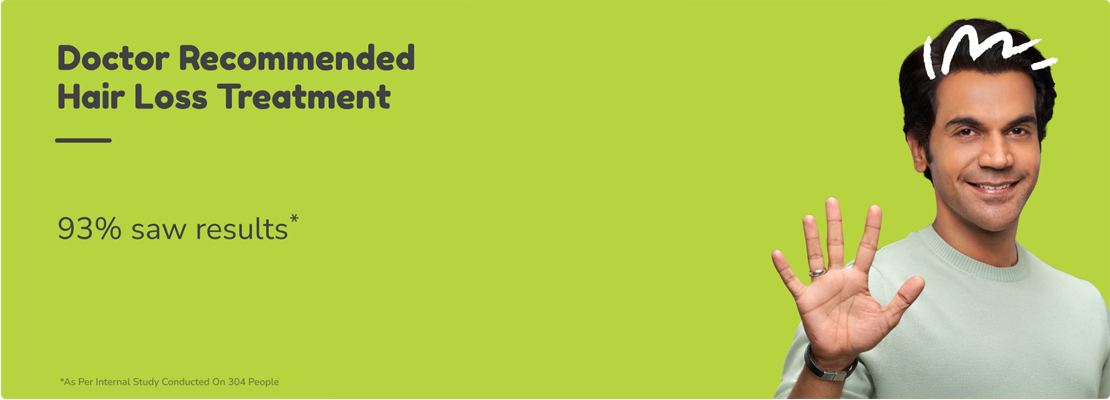Hair loss is a nightmare that everyone dreads. But the one thing that you should not do is stress over it, the more you panic, the more hair you will lose due to stress. You need to act early and visit a hair expert to decide on an appropriate hair loss treatment plan to ensure that your hair loss is arrested.
What is hair loss?
If you think you are suffering from hair loss looking at your comb, well think again. Hair loss is not the same as hair fall. We shed 50-100 strands of hair each day, shocking right? But anything more than that could be a matter of concern.
Hair loss is complex and can be caused due to a number of factors, internal as well as external. No, your hair loss is not just genetic, what you eat, your hormones, your metabolism, digestion, sleeping patterns, levels of stress and activity as well as environmental factors such as sun, dust, pollution, water, all of which result in hair loss. At Traya we believe that hair loss is a lifestyle concern- address your root causes to arrest further hair loss.
Yes, we mean it. There are seven hair stages of Pattern Baldness according to the Norwood Scale. Let us briefly touch upon each of those, to choose your best treatment plan.
Stage 1. In this stage, there is no noticeable hair loss and is referred to as the control stage. You might see hair loss but it is not visible.
Stage 2. Hair loss is noticed around the temples. This is referred to as an adult or mature hairline. However, the hair loss is not very prominent.
Stage 3. During this stage the first signs of clinically relevant balding can be identified. Both the temples lose hair and come to look like the letter M.
Stage 3 vertex. While the hairline remains at Stage 2 the hair loss happens on the top of the scalp or the vertex. Bald spots are also visible.
Stage 4. The loss of hair is quite severe and is reflected by the extreme hair loss at the hairline. Also, there is little or no hair left on the vertex. The Hairline is now U-shaped. At this stage the possibility of regrowing your hair is going to be tough but you can give it a shot.
Stage 5. At this stage the section separating the 2 areas where it is present becomes wider and the strip of hair in the middle becomes narrower with lesser growth. This stage is difficult to treat.
Stage 6. This is a virtually irredeemable state of hair loss The balding areas at the temples join with the balding area at the vertex. Hair transplant is a possibility at this stage but there is no real guarantee of success.
Stage 7. Here only the hair around the sides can be seen. This is usually fine hair and lacks density. Hair growth is very weak and does not remain for a sufficient period of time.
What is hair transplant?
To put it simply, a hair transplant is the procedure of attaching hair to the bald spot on the head from another site. It is a cosmetic procedure wherein a surgeon or a dermat removes hair follicles from one section of the body (also referred to as the ‘donor site’) and reinserts it in the section where the individual is experiencing baldness, also known as the ‘recipient site’. The procedure is also called follicular unit transplantation. Modern techniques are minimally invasive and details are usually given to the patient after an initial consultation. The best approach is suggested and a sequence of possible outcomes given to the patient.
It usually requires three to four sessions in order to achieve your desired results. A surgeon schedules sessions several months apart so that each transplant is fully healed. After two to three weeks of transplant, it is common for transplanted hair to fall out. This allows new hair to grow. It takes about 8 to 12 months after surgery to notice full growth.
Most dermats prescribe Minoxidil or Finasteride to improve hair regrowth. These medications in effect help slow future hair loss. A hair transplant is not a foolproof solution to hair loss. You need management lifelong, it is important to set realistic expectations and get all the necessary information.
Also Read : Finasteride - Uses, Side Effects & Precautions
A hair transplant is ideal for someone who is in stage 6-7, for others, Traya provides a holistic treatment plan with 97% efficacy. Don’t believe it? hear it from our customers but before that know why we say that more than 35000 customers have happy smiles and fuller hair!
The Traya Treatment Procedure
Traya has a three-fold way of treating hair loss. We combine the best of the 3 sciences Ayurveda, Dermatology and Nutrition to tackle hair loss. Before starting the treatment, we ask you to fill a form which allows our doctors to diagnose your hair loss. We provide you with a detailed analysis of your diagnosis and prescribe a suitable plan. Based on this, a plan is designed, which helps decide the route of treatment. A doctor individually looks at every case and gives a prescription.
At Traya, we understand that hair loss is complex and aim at providing a sustainable solution. We found that just one approach isn’t as effective as Nutrition, Dermatology and Ayurveda combined. Dermatology provides clinically tested medications which reduce hair loss. Our Hair Growth Serum, Minoxidil, Anti-Dandruff Shampoo and Scalp controller are made up of scientifically proven ingredients to treat hair problems. Whereas, Nutrition addresses nutrient deficiencies in the body with proper diet and a Hair Vitamins. Oh yes, you can’t just buy products and vanish, we give out a diet plan and suggest some lifestyle changes for both wholesome hair growth and living.
Lastly, looking through the lens of Ayurveda, we aim to resolve dosha imbalances in the body. Hair ras, Gut Shuddhi, Health Tatva, Nasal Ghrit, Scalp oil , all aim at improving the quality of life and that of your hair. We value our customers and maintain full transparency right from the start. We also treat hair loss upto stage 4 and provide a money back guarantee, because we believe that our treatment provides visible results.
Takeaway
If you are wondering whether or not you should go for a transplant and are anywhere between stage 1-4, we want to highlight a certain key points-
Transplant needs a lot of maintenance and care to sustain your brand-new crop on top. The transplanted hair is very fragile and needs to be protected diligently. Any sort of infection however minor could spell a swift end to the success of your hair regrowth plans.
Whereas, at Traya we help you with some of the best techniques of maintaining your hair loss. Our team of doctors and hair coach monitor your progress, hair experts conduct periodic reviews and gather feedback, you will never have to deal with hair loss alone! Get started on your treatment today.



